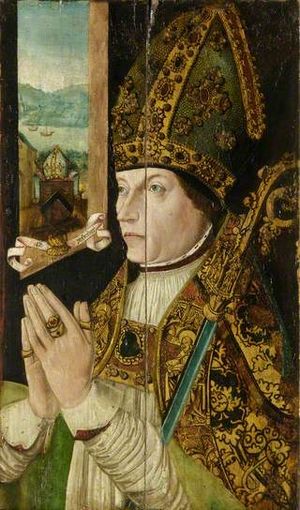James Hommyll facts for kids
James Hommyll was a rich merchant who lived and worked in Edinburgh, Scotland, from about 1473 to 1515. His last name could also be spelled "Hommyl" or "Homyl". James Hommyll's father was also named James Hommyll, and he was a tailor for the king.
Contents
James Hommyll the Elder and King James III
James Hommyll's father, also named James Hommyll, was the king's tailor. In August 1473, he made a fancy black velvet jacket for James III of Scotland. He also lined a blue gown for the king in 1474.
In January 1478, King James III gave the tailor a regular payment of £20 every year. This payment was called a "pension." He was seen as part of the king's close group of helpers and even received money to fix his own house.
There were some troubles in 1482, and some people close to King James III faced problems. However, James Hommyll the elder's pension was still paid for several years after this time. In 1488, he was punished for leaving Scotland after a battle. He had joined a group sent to England by King James III against his son's supporters. But later, King James IV forgave him.
James Hommyll's Career as a Merchant
James Hommyll was a merchant who traded a lot with a region called Flanders (which is now part of Belgium). He sold fancy fabrics to King James IV. For example, in 1495, he supplied crimson satin and other cloth for the king's clothes.
Hommyll also provided King James IV and his wife, Margaret Tudor, with beautiful tapestries to decorate their palaces. These tapestries showed scenes like Hercules, Susanna, Solomon, and Marcus Coriolanus.
In December 1503, the king bought a fine scarlet hat from James Hommyll. The king also bought clothes for James Hommyll's younger brother, William Hommyll. William was a courtier (someone who attended the royal court) and also a merchant who traded with Flanders. King James IV even sent William Hommyll as his messenger to Portugal in December 1503.
Around 1503 or 1504, James Hommyll hosted some servants of the King of Spain at his house in Edinburgh.
On November 26, 1504, four African people, who had been at Dunfermline Palace, stayed at Hommyll's house in Edinburgh. These people were called "Ethiopians" in the royal records. They probably included Ellen More and her sister Margaret. Hommyll also hosted a Portuguese man who was with the African people, along with two horses and other animals belonging to the king. On December 11, an African woman was christened (baptized).
In March 1507, the king bought an "image" from Hommyll for £18 Scots. This was likely a religious painting or a sculpture. In January 1508, Hommyll supplied gold leaf to the king's painter, a Flemish artist named Piers. This artist might have painted the portrait of James IV that is now at Abbotsford House.
Hommyll's Houses in Edinburgh

James Hommyll and his wife, Helen, owned a house on the south side of the High Street in Edinburgh. This house was part of a larger building owned by Lord Borthwick. On March 2, 1507, they gave this property to their son. If their son died without children, it would go to their daughter, Marion Hommyll.
Other people who lived in Lord Borthwick's building included Henry Martyne, John Wilson, Robert Barbour, and John Gren. The Hommyll family's part of the building had rooms on two floors. In September 1511, Hommyll received money because his house was burned down. A bakery next to Lord Borthwick's building had caused the fire. It seems that Ellen More and her companions had stayed in Lord Borthwick's building, next to this bakery, in the winter of 1504.
In December 1510, Hommyll gave a regular payment from another property he owned to help support the altar of St Anthony in St Giles' Kirk. This payment was called an "annual rent."
Hommyll and Andrew Halyburton
James Hommyll had many business dealings with Andrew Halyburton. Halyburton was a merchant and an important official in Middelburg, Flanders. He was known as the "Conservator of the Scottish Staple," which meant he looked after the business rights of Scottish merchants in the Low Countries.
Halyburton kept a notebook of his business deals, which is now held by the National Records of Scotland. Halyburton and Hommyll worked together and Halyburton even called Hommyll "his brother."
Hommyll traveled to Middelburg, and Halyburton would send money back to Scotland with him for other clients. Hommyll also delivered a clock in a new case that Halyburton had ordered to be fixed for the Bishop of Aberdeen. He also took some items to England for Halyburton.
Halyburton paid a debt for Hommyll to Jerome Frescobaldi in Antwerp. Frescobaldi was a supplier of textiles to King James IV. Hommyll sent gifts of salmon to Frescobaldi, which Halyburton delivered. Halyburton sold velvet and dyes to Hommyll.
Like many of Halyburton's clients, Hommyll sent sacks of wool to Flanders, which Halyburton sold to merchants there. Some of the wool came from Melrose, and some from Ettrick Forest. Halyburton's main business was trading Scottish raw materials, like wool, for fancy goods from Flanders.

